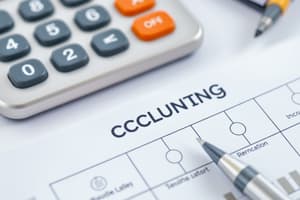Podcast
Questions and Answers
What sequence appears frequently in the content?
What sequence appears frequently in the content?
- gsss
- 2222222 (correct)
- nnnnnn
- :ssss (correct)
Which of the following patterns could suggest repetition?
Which of the following patterns could suggest repetition?
- .s)..s
- )?gss) (correct)
- s.s)s.s)
- ysssss: (correct)
Identify the pattern that appears to represent a question in the content.
Identify the pattern that appears to represent a question in the content.
- sss )yss)
- ss)s sssssss
- s)?g)
- ?:s)s (correct)
Which of the following sequences is used to denote a proper ending or conclusion?
Which of the following sequences is used to denote a proper ending or conclusion?
What common character is used as a separator or to indicate continuity?
What common character is used as a separator or to indicate continuity?
Which symbol seems to represent emotional context or response in the content?
Which symbol seems to represent emotional context or response in the content?
Identify the combination that appears to share a common thematic link with the rest.
Identify the combination that appears to share a common thematic link with the rest.
What structure indicates a form of complexity or multiple components within the content?
What structure indicates a form of complexity or multiple components within the content?
What is the primary focus of the content?
What is the primary focus of the content?
Which statement best captures the tone of the content?
Which statement best captures the tone of the content?
What type of language is predominantly used in the content?
What type of language is predominantly used in the content?
What kind of interactions are discussed in the content?
What kind of interactions are discussed in the content?
Which of the following best describes the complexity mentioned in the content?
Which of the following best describes the complexity mentioned in the content?
What is the likely audience for the content?
What is the likely audience for the content?
What aspect of systems is least emphasized in the content?
What aspect of systems is least emphasized in the content?
What is a likely consequence of the interactions discussed?
What is a likely consequence of the interactions discussed?
What is the primary symbol used in the text?
What is the primary symbol used in the text?
What does the combination 'ss)' suggest in the text?
What does the combination 'ss)' suggest in the text?
Which of the following terms appears to be used to express uncertainty in the text?
Which of the following terms appears to be used to express uncertainty in the text?
Which element is repeated frequently, indicating its importance?
Which element is repeated frequently, indicating its importance?
What does the configuration 'sssss)' imply about the tone of the text?
What does the configuration 'sssss)' imply about the tone of the text?
Which group of symbols could denote a transition or change in thought?
Which group of symbols could denote a transition or change in thought?
What does the presence of 'yy' likely represent in the context?
What does the presence of 'yy' likely represent in the context?
What can be inferred about the content with the phrase ':s:s)'?
What can be inferred about the content with the phrase ':s:s)'?
Which of the following phrases could represent an incomplete idea?
Which of the following phrases could represent an incomplete idea?
What does the multiplicity of 's' in 'gsg)' likely indicate?
What does the multiplicity of 's' in 'gsg)' likely indicate?
Which repeated pattern can suggest emphasis or importance?
Which repeated pattern can suggest emphasis or importance?
What is implied by the presence of 'sss)?' in the text?
What is implied by the presence of 'sss)?' in the text?
What could '0s)' signify in the context?
What could '0s)' signify in the context?
Which of the following seems to convey excitement or urgency?
Which of the following seems to convey excitement or urgency?
What does the repeating pattern 'ssl' likely represent?
What does the repeating pattern 'ssl' likely represent?
Flashcards
Unidentifiable Pattern
Unidentifiable Pattern
A series of symbols that do not form a recognizable pattern or represent a known concept.
Repeating Sequence
Repeating Sequence
A sequence of symbols repeated multiple times in a pattern.
Series of Numbers (Partial)
Series of Numbers (Partial)
A sequence of numbers that is only partially visible, some numbers missing.
Complex Symbol Clusters
Complex Symbol Clusters
Signup and view all the flashcards
Unique Symbol Combinations
Unique Symbol Combinations
Signup and view all the flashcards
Abstract Image
Abstract Image
Signup and view all the flashcards
Unreadable Characters
Unreadable Characters
Signup and view all the flashcards
Partial Data/Information
Partial Data/Information
Signup and view all the flashcards
Symbol Repetition
Symbol Repetition
Signup and view all the flashcards
Symbol Clusters
Symbol Clusters
Signup and view all the flashcards
Symbol Placement
Symbol Placement
Signup and view all the flashcards
Symbol Variation
Symbol Variation
Signup and view all the flashcards
Symbol Combination
Symbol Combination
Signup and view all the flashcards
Symbol Hierarchy
Symbol Hierarchy
Signup and view all the flashcards
Symbol Relationships
Symbol Relationships
Signup and view all the flashcards
Symbol Interpretation
Symbol Interpretation
Signup and view all the flashcards
Patterned Sequence
Patterned Sequence
Signup and view all the flashcards
Symbol Grouping
Symbol Grouping
Signup and view all the flashcards
Symbol Meaning
Symbol Meaning
Signup and view all the flashcards
Data Presentation
Data Presentation
Signup and view all the flashcards
Code Representation
Code Representation
Signup and view all the flashcards
Symbol Arrangement
Symbol Arrangement
Signup and view all the flashcards
Symbol Connection
Symbol Connection
Signup and view all the flashcards
Abstract Pattern
Abstract Pattern
Signup and view all the flashcards
Pattern Recognition
Pattern Recognition
Signup and view all the flashcards
Pattern Discernment
Pattern Discernment
Signup and view all the flashcards
Study Notes
Business Administration - Paper MMBACCT 103
- Full Marks: 80
- Time: 4 hours
- Internal Assessment: 20 marks
- Instructions: Answer questions in own words. Figures in the right margin indicate marks.
Question 1 - Answer any 10 of the following
-
a) Accounting Cycle Definition: Briefly describe the accounting cycle.
-
b) 2 Indian Accounting Standards (IAS): Briefly describe any two Indian Accounting Standards (IAS).
-
c) Accrual vs. Cash Accounting: Define accrual and cash basis of accounting.
-
d) Contingent Liability Example: Define contingent liability with an example.
-
e) Artificial & Representative Personal Accounts: Give one example of each: Artificial Personal Account and Representative Personal Account.
-
f) Trial Balance Objectives: State the two objectives of preparing a trial balance.
-
g) Purchase Return Journal Entry: Write the journal entry for a purchase return.
-
h) Capital, Revenue, or Deferred Revenue Expenditure: Identify whether the following are capital, revenue, or deferred revenue expenditure:
- Carriage of machinery: 17,200 (revenue)
- Research and Development: 1,20,000 (capital)
- Servicing vehicle (including oil change): 3500 (revenue)
- Basement construction: 14,75,000 (capital)
-
i) Cost Accounting Objectives: Write any two objectives of cost accounting.
-
j) Prime Cost Definition: Define prime cost.
-
k) Margin of Safety Definition and Context of Marginal Costing: Define margin of safety in the context of marginal costing.
-
l) Break-Even Point Indication: Define what Break-Even Point indicates.
-
m) Money Measurement Concept of Accounting: Define the Money Measurement Concept of accounting.
-
n) Direct and Indirect Cost Example: Give one example of direct cost and indirect cost.
Question 2 - Answer any 4 of the following (5 marks each)
- a) Journal Entries: Journalise the following financial transactions:
- Payment to Mr. X (creditor): Rs. 1,25,500
- Other 3 Questions (omitted): (Details of remaining questions omitted).
Question 3 - Answer any 4 of the following (10 marks each)
- a) Accounting Concepts: Discuss Business Entity, Going Concern, Cost Concept, and Accounting Period concept.
- b) Depreciation Policy: Write the objectives of depreciation policy and the calculation of plant depreciation (using Diminishing Balance Method) for a machine purchased on 01.04.2018 for Rs. 10,00,000, over three years, charging depreciation at 8% per annum in a plant account.
- c) Trial Balance: Prepare the trading account, profit & loss account, and balance sheet as on 31.03.2022 from the given trial balance and additional information.
- Additional Information:
- Closing Stock: Rs. 72.600
- New Machine Installation: Rs. 15,400 (not recorded)
- Wages for machine erection: Rs. 1,100
- d) Short Notes (4): Write short notes on manufacturing (mfg) account, double entry system, semi-variable costs, and margin of safety.
- (Additional information omitted): (details for remainder of question omitted).
Question 4 - Answer any 4 of the following (10 marks)
- a) Cash Break-Even Point : Explanation and Importance of preparing final accounts
- b) Final Accounts Detail: Importance of final accounts and Bad Debts provision and its position in Balance Sheet
- c) Limiting Factor: Elaborate on the concept of limiting factors in decision-making.
- d) New Product Introduction Advice: Advise the management (B.Ltd) on the profitability of introducing a new product (Y) given the details of the existing product (X).
Studying That Suits You
Use AI to generate personalized quizzes and flashcards to suit your learning preferences.




